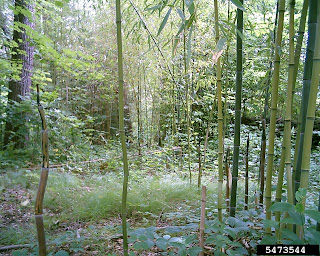 |
| Yellow groove bamboo, Phyllostachys aureosulcata invading a natural area image by Caryn Rickel, Institute of Invasive Bamboo Research, Bugwood.org |
For each
community there comes a time when the invasive impact of a charismatic mega
species finally causes an epiphany and an interest in one century of concern
takes hold. Most of us are comfortably landscape illiterate and cannot be bothered
with an invasive species especially if it is a plant, because most of us
identify a plant as a tree or shrub, flower or grass and, then, quickly move on to our morning
coffee. We no longer know the common
names, and sure enough cannot deal with the impossible to pronounce
alien-exotic sounding names such as Phyllostachysaureoculcata McClure (1945) at any time of the day.
Mount
Rainier, a small town in Prince George's County, Maryland, my county, has found
itself under attack from past landscape practices of its own doing, and now
wants action and proposes a ban on all invasive plants. The immediacy of the
idea obscures the question as to what exactly is an invasive plants, but
oppressed homeowners and beleaguered politicians seldom let actual context
interfere with well-meaning intentions. The press, of course, does not have the
time or resources to actually talk to people who know a little or much about
invasive species, but rather focus
on factoids that sell news by fanning the flames of simplistic thinking.
Invasive
species issues are seldom, if ever, linear. They are not solved by direct line
thinking. Simple solutions like a city ban will not solve the existing problem.
This is the wicked
inconvenience of invasives. Simple solution will inevitably cause
unintended consequences and more problems. Invasive species impacts are wicked
problems because they involve many vested interests, ill-defined definitions,
limited resources and short, near term frame of mind goals (interest is lost
easily). For example, a land manager invests the money and time to remove a
weed from a play ground but does not have a long term plan for what comes next,
resulting in a new species quietly establishing because there was no EDRR plan
put in place as part of the original plant removal.
Mount
Rainier has a bamboo problem. Which bamboo exactly is causing the problem? This
is a trick question because almost assuredly they have no idea that there are
26 species in the genus. Most likely, they are dealing with one of two
possibilities, but what reference are they using to establish that
identification. More worrisome is the idea that a ban will solve the problem. A
ban will solve tomorrow's neighbors' incursion but today's property owners will still be left with the financial burden of mitigating the damage to get back full
use of their land. The real issue is how to make existing property owners
whole. Who is responsible for the loss of the use of my land when a neighbor's
invasive species jumps the fence?
There is
little doubt that some species of invasives especially certain bamboos can rip
part patios, chew through foundations, uproot asphalt, grow through concrete,
and otherwise make practicable use of a property impossible for any reason. And
these few specific bamboos are not alone in the invasive category - just ask the Confederacy about
kudzu, fire ants and pythons to name a few. It is good to remember that in
spite of these facts, bamboo, as of now, mostly impacts managed gardens,
properties, and landscapes. Because the term of art invasive species comes out of ecological and natural land
management investigations, the labeling of bamboo as 'invasive'
causes definitional problems.[1] It
would be better, perhaps, if
historically we had not separated the idea of weeds and invasive plants, but we
have. The so-called 'running' bamboos are destructive, aggressively harmful,'noxious' landscape weeds that do not fit well into classic invasive species
categories especially those that require harm to natural areas and that require
seeding pressure (something these bamboos do not do - yet).
For over
thirty years a generation of dedicated volunteers and professionals has been
trying to get the rest of us to notice that we have a problem, but until the
problem costs us personally, we do nothing preferring to be ecological
ostriches.
Mount
Rainier needs a plan before a law. It needs to put a cutting edge comprehensive
program together that involves sustainable
landscaping practices (SITES). The town needs an outreach program to its
citizens on what the problem is and what they can do about it personally. The town needs to support through information
web sites best management practices for new installation and old landscape
maintenance strategies (integrated pest management practices: IPM). The town
should be putting together an early
detection and rapid response (EDRR) program do ensure they never have this
kind of problem again. And finally, Mount Rainier should be advocating for a
county-wide policy, for every community is part of an ecosystem, and invasive
species issues must be managed holistically at the ecosystem level.
[1] As
per Executive Order 13112 an "invasive species" is defined as a
species that is:
1) non-native (or alien) to
the ecosystem under consideration and
2) whose introduction causes
or is likely to cause economic or environmental harm or harm to human health.
No comments:
Post a Comment